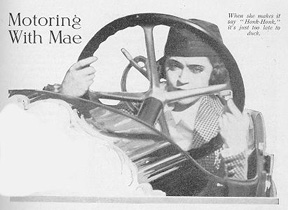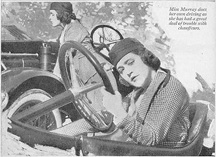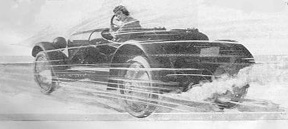 "I have never faced the cannon's mouth; I have never heard the battle's roar; I have never been in an aeroplane; but I have no fear of them, or other sudden deaths, because I have been motoring with Mae.
"I have never faced the cannon's mouth; I have never heard the battle's roar; I have never been in an aeroplane; but I have no fear of them, or other sudden deaths, because I have been motoring with Mae.Mae Murray is nothing if not a careful driver--careful of others. She had much rather run her car up a tree than even startle a stray dog--she'd even prefer to hurdle the dog.
When Miss Murray first quit New York for the Lasky studio and took one glimpse of the roads, orange groves, etc., of Southern California . . . she decided that she must have an automobile. She told the dealer that she wanted one with lots of horse power as she was fond of dumb animals. A low, red, rakish thunderbolt was her selection; one of these wicked-looking affairs that spell speed and make the motor cops take its number on suspicion even when it is standing against the curb.
The thing had eight cylinders, or so. . . .Miss Murray remarked that eight cylinders were enough to start with, seeing as how it was her first car, but later on she might get more, but as she was new to the pictures, eight was enough for any ingenue.
Don't think for a moment that Miss Murray is not familiar with automobiles. She is an expert mechanician. . . .Of course she makes mistakes now and then, as to the proper thing to step on at the proper time--but then, no one is perfect. What would the world be if everyone was perfect--and who would be so mean as to begrudge a poor working girl the right to step on the accelerator when she should step on the brake, especially when it is her very own car?
Miss Murray does her own driving as she has had a great deal of trouble with chauffeurs. They kept bouncing off the lackey's seat on the side of the car and she would have to stop, turn around and go back and pick them up, which was a terrible waste of time, especially if she had an appointment. She kept a mechanician at home to clean the machine and help pull it back through the rear end of the garage when she came home from work--but on the road she is her own chauffeur and mechanic.
 The Lasky star has a clever plan of keeping down the upkeep--she only drives on two wheels at a time letting the other two tires spin around in the air and cool off. You can't imagine what a weekly saving in tires this is. According to certain records kept by the City of Los Angeles, Miss Murray owns the only fox-trotting automobile in captivity. When she makes it say "Honk-Honk" it's just too late to duck. . . When she goes by in her car, the whole town turns out--of the way."(54)
The Lasky star has a clever plan of keeping down the upkeep--she only drives on two wheels at a time letting the other two tires spin around in the air and cool off. You can't imagine what a weekly saving in tires this is. According to certain records kept by the City of Los Angeles, Miss Murray owns the only fox-trotting automobile in captivity. When she makes it say "Honk-Honk" it's just too late to duck. . . When she goes by in her car, the whole town turns out--of the way."(54)Other actresses redesigned their cars to their specifications. Bessie Eyton converted the little Maxwell that succeeded her big Paige into her very own dressing room on wheels, an innovation that attracted the attention of Mary Pickford who drove a similar Maxwell at the time. Pathe serial queen Ruth Roland drove a foreign coupe which she designed herself. Noted Mabel Condon who rode with Ruth in her "odd" new car in 1916:
Mrs. Bridgwood patented the invention in 1917, just after the TRICO company introduced hand-operated wipers. The Bridgwood device used rollers rather than blades and was powered by electricity. Unfortunately, despite its technical advance, Florence and her mother were not successful in marketing their invention. It would not be until 1923 that the automatic windshield wiper would be introduced as a standard feature on cars and the women who had pioneered this extremely useful innovation would receive no recognition or remuneration at all. Perhaps the world was simply not ready to concede that females had the knowledge to develop mechanical devices capable of improving automobiles.
